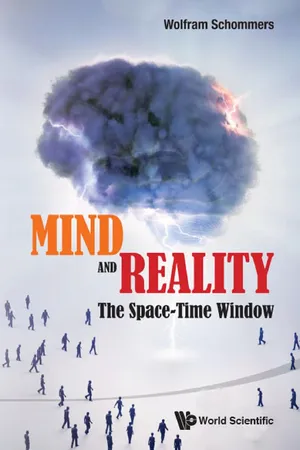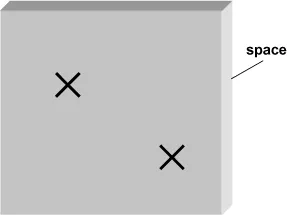![]()
Chapter One
BASIC QUESTIONS
In natural science, the observations in everyday life are of particular relevance. We normally base our analysis on those events and things which are spontaneous in front of us; we experience these events and things directly without any interpretation. In such situations we have humans, trees, cars, the sun, the moon, stars and a lot of other things (see Fig. 1) directly in front of us and they appear without any intellectual help [1, 2].
1.1 THE SPACE AS CONTAINER
This kind of world is grasped within so-called “assumption-less observations” in everyday life, and this kind of reality is experienced by each human being in the same manner. A typical example is given in Fig. 1. This world, which we often call “material reality” and which is experienced by assumption-less observations, appears to be embedded in space. On this level reality is considered as a “container” in which the masses are positioned where the container itself is identical with that what we consider as space. Let us call this concept “container principle”.
Once again, within such assumption-less observations in everyday life certain macroscopic bodies appear: human beings, trees, cars, houses and other things. But these impressions can be refined by more sophisticated observations, that is, we perform measurements. In this way we extend our knowledge about how the world and atoms, molecules, elementary particles, galaxies, suns and planets appear. However, all these things do not change the container principle concept which is reflected through our assumption-less observation in everyday life (Fig. 1). The only difference is that the number of entities, positioned in space, seem to be extended and there are not only the macroscopic bodies (trees, etc.) in the container which we observe in everyday life (Fig. 1); there are additions such as atoms, molecules, etc.
Fig. 1 The image shows the world in front of us within an assumption-less observation, experienced without any intellectual help. The world (material objects) appears to be embedded in space, and this situation defines the so-called container principle.
1.1.1 Basic Information
We put all these additional things intellectually into the container and develop on this basis theoretical conceptions that work in most cases excellently. For example, we are able to calculate the movements of planets around the sun very precisely.
All these facts, based on assumption-less and other observations as well as on theoretical conceptions, can be called the “basic information” about reality. But is this “basic information” identical with the “absolute truth”? Can a container filled with material entities be considered as the absolute truth?
Fact is that the human observer is caught in space and time. The observations in everyday life (an example is given in Fig. 1) appear in space, and life develops in the course of time. We construct visual and abstract ideas in space and time in a most natural way.
Fact is also that the impressions that we have directly in front of us — before our eyes — are images of the world outside, which are positioned in the brain, and yet these images appear to be in front of us. In other words, Fig. 1 and all the other direct impressions in front of us are merely images of the world outside. Is there evidence for that? Yes, it is. In Appendix A we bring specific experiments which clearly demonstrate that a spontaneous impression in front of us (Fig. 1) cannot be the actual world outside.
It is essential to mention that the images in front of us come not into existence through the information of the world outside alone, but the eye, the optic nerves and the brain work here together. In other words, the impressions which are in everyday life spontaneous in front of us are dependent on the observer itself and cannot be considered as observer-independent. Thus, the above introduced notion “basic information” is observer-dependent. Nevertheless, this “basic information” could still reflect a certain form of “absolute truth”.
Up to now we have nothing said about the structure of the material world outside. A short form of Fig. 1 is given by Fig. 2. We come to the container principle if we replace the crosses, the geometrical symbols, in Fig. 2 by real bodies (masses), i.e. the world outside is defined by a space in which two real masses are embedded leading to Fig. 3.
In other words, we have to distinguish between a “world outside” and an “inside world”. Within usual (conventional) physics, in particular within Newton’s mechanics, it is assumed as a matter of course that there is one-to-one correspondence between reality outside and that what is positioned in our brain (inside world).
Fig. 2 For the image of reality inside the brain, which appears in front of us, we have chosen a simple form given by two geometrical symbols (two crosses in the figure) that are embedded in space, that is, instead of the complex geometrical structure in Fig. 1 we have two crosses.
Fig. 3 Within the container principle the world outside consists of a space in which the material bodies (full points in the figure) are embedded.
We experience the world by our sense organs, i.e., the observer interacts with reality outside: Information about the world outside flow via our senses into the body, and the brain forms an image of the world outside. In other words, we have a reality outside and an inner image of it, and we are usually firmly convinced that the structure of the inner picture (see for example Fig. 2) is identical with that of reality outside (see for example Fig. 3); that is, it is always assumed that there is a one-to-one correspondence. For example, the well-known psychologist C. G. Jung (1875–1961) wrote [3]: When one thinks about what consciousness really is, one is deeply impressed of the wonderful fact that an event that takes place in the cosmos outside, produces an inner picture, that the event also takes place inside ….
This statement by C. G. Jung suggests just that what we have already pointed out: The image as well as the real world outside are embedded in space and time.
Clearly, the world in front of us is the inside world but this is not essential because the structure of the inside world (Fig. 2) is identical with that of the world outside (Fig. 3). Therefore, we always assume (consciously or unconsciously) that we have the physically real world outside directly in front of us. We maintain this view in this monograph when we talk about man’s usual conception of the world which is given by the container principle. However, we will recognize that this one-to-one correspondence is not realistic and we come to the so-called projection principle.
1.1.2 No Direct Access to the World Outside!
The impression in front of us reflects an inner state within the brain of the observer. The problem is that we have no direct access to the world outside. The simplest assumption is that there is a one-to-one correspondence between the structure in the image (Fig. 2) and the structure of the world outside (Fig. 3), and we come to the container principle. Although this principle is used in conventional physics, the assumption of an one-to-one correspondence seems to be too simple and too naive. Nevertheless, most people believe in this conception, almost always unconsciously; as a typical example we have quoted above the standpoint of C.G. Jung.
Only a few scientists and philosophers treat this problem more critically, but do not come to a definite result. John Borrow remarks [4]: There are two poles about the relationship between true reality and perceived reality. At one extreme, we find ‘realists’, who regard the filtering of information about the world by mental categories to be a harmless complication that has no significant effect upon the character of the true reality ‘out there’. Even when it makes a big difference, we can often understand enough about the cognitive processes involved to recognize when they are being biased, and make some appropriate correction. At the other extreme, we find ‘anti-realists’, who would deny us any knowledge of that elusive true reality at all. In between these two extremes, you will find a spectrum of compromise positions extensive enough to fill any philosopher’s library: each apportions a different weight to the distortion of true reality by our senses.
Again, the problem is to find a realistic conception for the world outside, which is not directly accessible to empirical tests. The container principle with its one-to-one correspondence seems to be too naïve, but this statement has to be justified, and we will do that in this monograph step by step.
1.1.3 The Container
The following question arises: Can our immediate experience in everyday life really reflect the “true structure” of the world outside, i.e., the “absolute truth”? Most people would spontaneously say “yes it does” because they firmly assume that the container principle is valid. However, we have to be careful. Fact is that all the things we experience in everyday life (an example is given in Fig. 1) cannot be considered as “absolute truth”. In the following we will justify this standpoint, and we will in particular analyze the real situation in detail.
The structure of the world within assumption-less observations reflects a certain level. The levels on which we develop theories and interpretations are in general more sophisticated and also more detailed. However, also at these scientific levels we work within the container principle; in other words, the container principle is not affected when we go from the facts of assumption-less observations to scientific theories. All theories about the world, from Newton’s mechanics, to the Theory of Relativity to all forms of conventional quantum theory, have been based on the container principle. But does this principle reflect the real situation? We will recognize that this conception is problematic.
We may state that the container principle is considered in conventional physics as the “basic truth”. Whether this basic truth can be identified with the “absolute truth” remains here an open question; it strongly dep...




